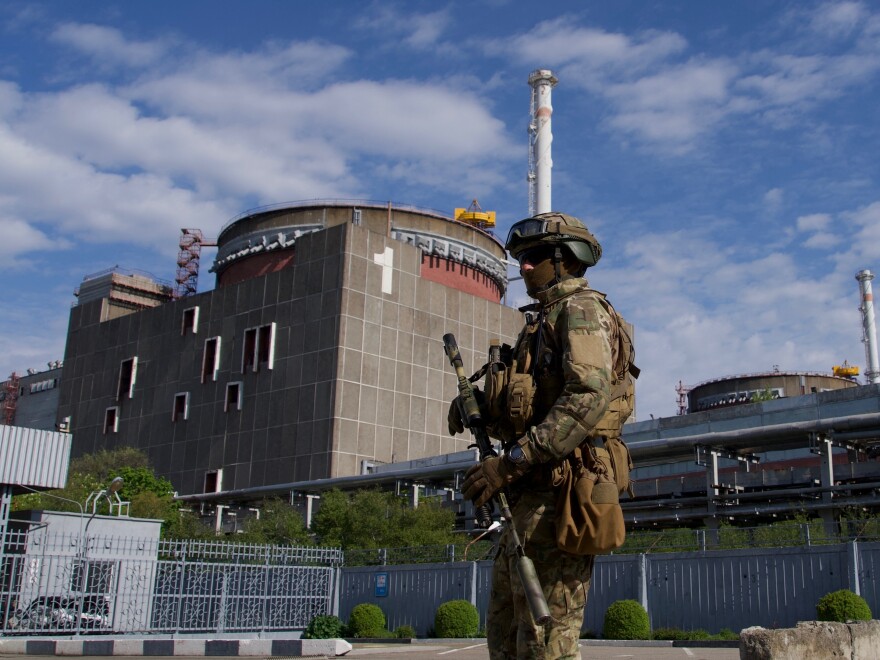Over the weekend, Ukraine's Zaporizhzhia nuclear power plant — the largest such plant in Europe — came under fire. Who was behind it remains unclear: Ukraine and Russia blame each other for the attacks. What is clear, is that the strikes are coming nearer to and have already damaged some critical parts of the sprawling nuclear complex.
An NPR analysis of satellite imagery and posts to Twitter, Telegram and YouTube over the past month show how an escalating conflict at the plant is drawing ever closer to critical safety systems and radioactive materials, ratcheting up the chance of a nuclear disaster.
Loading...
Satellite imagery from the company Planet taken in early July and over the weekend shows Russian troops positioned inside the plant perimeter, along with some of the damage caused by military strikes around the nuclear facility. The fighting comes at a time when Russia is attempting to formally annex the Zaporizhzhia region, where the plant is located. Analysis from the Institute for the Study of War suggests that the renewed nuclear tensions coincide with the United States delivering heavy weapons to Ukraine, which has used them to re-take significant portions of southern Ukraine all summer.
Over the weekend the International Atomic Energy Agency director general, Rafael Mariano Grossi, warned that the situation at the power station could spiral out of control.
"Military action jeopardizing the safety and security of the Zaporizhzya nuclear power plant is completely unacceptable and must be avoided at all costs," he said in a statement. "I strongly and urgently appeal to all parties to exercise the utmost restraint in the vicinity of this important nuclear facility, with its six reactors."
Early July: A satellite image shows Russian forces were encamped within the plant perimeter
Russian troops took the Zaporizhzhia nuclear plant in early March in what experts described as a risky and reckless assault. Since then, the Russian military has been in firm control of the facility's six reactors, which continue to be operated by Ukrainian staff.
A satellite image taken on July 3 by Planet shows roughly a dozen military vehicles parked near some administrative buildings. The Russians also erected several large tents in a nearby lot, presumably to house the troops tasked with protecting the plant.
Loading...
Physically stationing Russian troops inside the plant will undoubtedly affect operations, according to Edwin Lyman, director of nuclear power safety at the Union of Concerned Scientists, a watchdog group. "It puts pressure on the Ukrainian staff at the plant," he says.
Dmytro Orlov, the exiled mayor of Enerhodar, the town where the power plant stands, said on Ukrainian television that workers' morale is at an all-time low, especially after Russian soldiers reportedly beat an employee to death in July.
Late July: That Russian encampment became a target for Ukrainian forces
❗ Українські військові ювелірно відпрацювали по позиціях російських окупантів біля Запорізької АЕС.
— Defence intelligence of Ukraine (@DI_Ukraine) July 22, 2022
▪ Використовуючи дрон-камікадзе було знищено 3 рашисти, 12 травмовані. Наметове містечко знищене пожежею, яку довго не могли загасити. pic.twitter.com/tkQfKHxoCX
On July 22, the Ukrainian Defense Ministry's intelligence wing tweeted a video of an apparent drone strike on the encampment. The video showed an explosion near the tents, which caused dozens of Russian troops to flee. The video then shows the tents on fire. The Ukrainian ministry claimed that the kamikaze drone injured 12 soldiers and killed three others.
Satellite images corroborate that video. Low-resolution imagery from Planet shows the strike may have occurred between July 19 and July 21. A higher-resolution image from Aug. 7 shows burn scars and damaged tents where the Russian encampment once stood.
"It did show that Ukrainians wouldn't hesitate to attack the Russian military inside the facility itself," says Wim Zwijnenburg, a researcher studying the environmental impacts of war for the Dutch nonprofit PAX.
Lyman says that the Ukrainians may have had confidence in the precision of their strike, but it was still a huge risk to hit inside the perimeter of the facility.
"That's clearly starting to play with fire," he says.
Early August: The Russians may have repositioned troops and equipment next to the nuclear reactors in response to the strike
The Aug. 7 image from Planet also shows that the military trucks first seen at the site in July appear to have vanished.
A separate video published by the Latvia-based Russian investigative journalism organization known as The Insider shows what appears to be drone footage of Russian vehicles being moved into buildings near the plant's massive nuclear reactors.
The drone video is dated Aug. 2. Although NPR could not independently verify the authenticity of the footage, Zwijnenburg showed that the video was shot at various locations around the nuclear plant.
Some of the military trucks in the footage also match those seen parked at the site in satellite imagery from Planet.
More Russian military equipment is being set-up at the #Zaporizhzhia Nuclear Power Plant in Enerhodar, a new drone video shows. Here's small thread with geo-locations and recent @planet high-resolution satellite imagery showing new military positions and strike impacts🧵1/x https://t.co/BPJa88tbUN pic.twitter.com/YM1TB4fI5M
— Wim Zwijnenburg (@wammezz) August 8, 2022
Russia had already reportedly been storing vehicles near the reactors, but it seems credible following the drone strike that they would move additional equipment closer in, Zwijnenburg says. "They probably stored [the vehicles] there to prevent any indirect strikes," he says.
Moving vehicles closer to critical buildings at the plant would significantly add to the danger factor, according to Lyman. In addition to making critical buildings a potential target, the trucks and armored vehicles themselves could contain ammunition or explosives that would be hazardous next to a nuclear reactor. "It depends what's in those vehicles," he says.
The latest strikes hit closer to critical parts of the plant
Footage from the Russian state media channel Zvezda over the weekend shows a fire burning near the plant's 750kV substation, which supplies power both in and out of the facility. Scorched areas from the fire are also clearly visible on the Aug. 7 satellite imagery from Planet. The IAEA says that the plant's power supply system was damaged in the strike.
Loading...
Lyman says that the substation is absolutely critical to the plant's safe operation. Nuclear reactors require the constant circulation of water through their cores in order to stay cool, and that, in turn, requires pumps powered by electricity.
"You don't want to jeopardize anything to do with the electrical equipment and the power lines," he says. If a plant does lose power, backup diesel generators can provide water for a time, but only if they've been well maintained. Lyman says that U.S. plants sometimes struggle to keep their generators in a continuous state of readiness.
"I don't know what the status of the surveillance and maintenance of the equipment is at this point at Zaporizhzhia," Lyman says.
A second Zvezda video appears to show what may be parts of a rocket that detonated near the plant's nuclear waste storage facility. The video shows the body of the rocket near the location, along with damage to a small support building near the waste site.
Zwijnenburg says the debris resembles a BM-27 Uragan short-range artillery rocket. Both Ukraine and Russia use the rockets, but they're usually fired in groups, or salvos, he says. The appearance of just a single weapon is "very strange."
"It's hard to establish the trajectory of the missile that hit the facility," he says. It may have been deliberate or a misfired weapon from either side.
Searching for a solution
Regardless, Russia may be adding more firepower to the site in response to the latest strikes. On Aug. 9, the Russian-installed administrator of the Zaporizhzhia region said on Russian television that the Russian military was adding more rocket systems around the plant, ostensibly to protect against Ukrainian attacks.
Lyman, at the Union of Concerned Scientists, says the situation appears increasingly dangerous. "There's kind of a slow deterioration of the safety posture at the plant," he says. "If there is sustained active combat, there's a pretty good chance you'll get a situation that you can't control."
IAEA Director General Grossi says he wants to send nuclear inspectors to the site, in an effort to stabilize safety and security there.
Evgeny Balitsky, the appointed Russian administrator for the region, says Russian engineers are maintaining the plant and he invited officials from the IAEA to inspect the plant. But Henry Sokolski, executive director of the Nonproliferation Policy Education Center, a nuclear think tank, believes that sets a dangerous precedent.
"You'd have to access the plant by traveling on a Russian passport, traveling through Russian territory. You can't go through Ukrainian territory, can't use Ukrainian passports, and you can't access it by going across the river," he says.
That also runs the risk of classifying the Ukrainian plant as belonging to Russia, which has different inspection protocols stemming from their nuclear weapons program.
"The IAEA is in a bind," Sokolski says.
Meanwhile, Mykhailo Podolyak, a top aide to Ukraine's President Volodymyr Zelenskyy, has argued for a demilitarized zone around the plant.
He cited a grain export deal brokered by the United Nations and Turkey as a potential model. The head of Ukraine's power utility recommended U.N. peacekeepers monitor the situation.
Others are calling for sustained international pressure to find a solution.
"The only safe way of ending this crisis is by creating a coalition of nuclear states — Japan, South Korea, the United States and so on — to pressure Russia to back out of the power plant entirely," says Hryhoriy Plachkov, the former head of Ukraine's nuclear regulator. "I don't think we can get them to leave with missiles."
Copyright 2023 NPR. To see more, visit https://www.npr.org.





